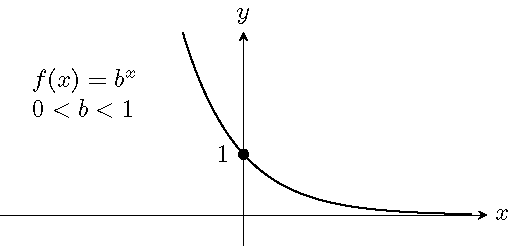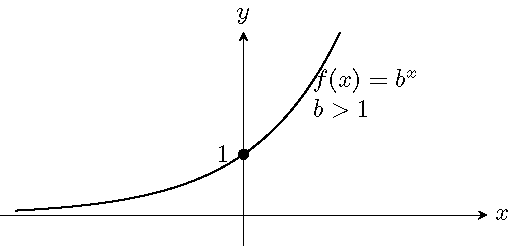Topic 16 Exponential Functions
16.1 Half-life
Half-life is the time required for a quantity to reduce to half of its initial value.
A certain pesticide is used against insects. The half-life of the pesticide is about 12 days. After a month how much would left if the initial amount of the pesticide is 10 g? Can you write a function for the remaining quantity of the pesticide after days?
More examples on exponential functions can be found on http://passyworldofmathematics.com/exponents-in-the-real-world/.
16.2 Definition and Graphs of Exponential Functions
Let be a positive number other than (i.e. and ). The exponential function of with the base is defined as
Graphs of exponential functions:


The exponential function is a one-to-one function: any vertical line or any horizontal line crosses the graph at most once. Equivalently, the equation has at most one solution for any real number .
16.3 The Natural Number
The natural number is the number to which the quantity approaches as takes on increasingly large values. Approximately, .
16.4 Compound Interests
After years, the balance in an account with a principal and annual interest rate is given by the following formulas:
- For compounding periods per year: .
- For compounding continuously: .
Example 16.1 A sum of is invested at an annual rate of , Find the balance, to the nearest hundredth dollar, in the account after years if the interest is compounded
- monthly,
- quarterly,
- semiannually,
- continuous.
Solution.
- Find values of , , and . In this case, , , and depends compounding.
- Plug the values in the formula and calculate.
- Monthly’’ means . Then
- Quarterly’’ means . Then
- semiannually’’ means . Then
- For continuously compounded interest, we have
In the compounded investment module, the is an approximation of the period interest rate. Indeed, if the period rate satisfies the equation , or equivalently . Using the formula , one may approximately replace by and obtain the approximation .
Example 16.2 The population of a country was about 0.78 billion in the year 2015, with an annual growth rate of about 0.4%. The predicted population is billions after years since 2015. To the nearest thousandth of a billion, what will the predicted population of the country be in 2030?
Solution.
The population is approximately
16.5 Practice
Problem 16.1 The value of a car is depreciating according to the formula: , where is the age of the car in years. Find the value of the car, to the nearest dollar, when it is five years old.
Problem 16.2 A sum of $20,000 is invested at an annual rate of 5.5%, Find the balance, to the nearest dollar, in the account after 5 years subject to
- monthly compounding,
- continuously compounding.
Problem 16.3 Sketch the graph of the function and find its range.
Problem 16.4 Use the given function to compare the values of , and and determine which value is the largest and which value is the smallest. Explain your answer.